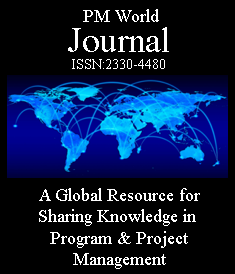FEATURED PAPER
By Bob Prieto
Florida, USA
Key Points:
-
- Critical Need for Measuring Uncertainty. Large complex projects (LCPs) are inherently uncertain due to technical, organizational, environmental, and temporal complexities—understanding and measuring this uncertainty is vital to avoid cascading overruns and missed objectives .
- Comprehensive Categorization of Uncertainty. The paper breaks down uncertainty into manageable categories—ethical, option, and state-space uncertainty—and further details subsets like technical, regulatory/legal, market, operational, and strategic uncertainties relevant to large complex projects.
- Development of Quantitative Metrics. Specific quantitative metrics like the Schedule Uncertainty Index (SUI), Cost Uncertainty Index (CUI), Technical Uncertainty Score (TUS), Composite Uncertainty Metric (CUM), and Engineering Project Uncertainty Index (EPUi) are outlined.
- Use of Advanced Analytical Tools. The paper outlines practical tools such as Monte Carlo simulations, Bayesian inference, probabilistic finite element models, and earned value management to dynamically model and update uncertainty assessments
- Integration of Market, Operational and Strategic Factors. Beyond technical parameters, the paper stresses measuring state uncertainty through market indicators, operational metrics, and strategic metrics
Introduction
Large complex engineering and construction programs are inherently fraught with interdependent variables, shifting stakeholder requirements, and external shocks—from supply-chain disruptions to evolving regulatory landscapes. As project scale and technical intricacy grow, so too does the uncertainty surrounding cost, schedule, and performance. Without a structured approach to measuring and managing both complexity and uncertainty, even well-funded ventures risk cascading overruns and missed objectives.
Complexity manifests in multiple dimensions:
-
- Technical (novel design features, untested materials)
- Organizational (distributed teams, multi-tier subcontracting)
- Environmental (site constraints, regulatory variation)
- Temporal (compressed schedules, evolving scope)
Uncertainty stems from data gaps, human judgment limits, and inherent randomness. In isolation, neither complexity nor uncertainty is fatal; together, they create a volatile cocktail that can undermine the most meticulously planned initiatives.
Understanding and tracking uncertainty in large complex projects (LCPs) isn’t just about risk registers and probability curves—it’s about dynamic insight. A structured approach, aligned with governance and integration best practices, is required. This approach must recognize that multiple types of uncertainty may exist simultaneously; that uncertainty, like complexity, is a fundamental characteristic of LCPs; and to be managed, it must be measured.
Types of Uncertainty
Uncertainty isn’t one-size-fits-all. Uncertainty may be divided into a set of manageable categories. At a high level, these categories have been described as encompassing ethical, option and state space uncertainty.
Ethical uncertainty relates to the value we should associate with the consequences of our choices. In some instances this can be more simply considered to be regulatory or legal uncertainties such as those related to compliance or actions or inactions taken in a political context. In some scenarios ethical uncertainty is removed by a conscious choice to take corrupt or widely regarded unethical actions. Along the spectrum from choices with clearly defined and acceptable consequences to choices with legally, or worse morally, unacceptable choices, there is a wide range of ethical uncertainty. These will not be discussed further in this paper but reference is made to the National Academy of Construction Executive Insights focused on corruption.[1]
A second broad category of uncertainty can be described as option uncertainty. Option uncertainty arises when we don’t know what the consequences of an action are. It is an empirical uncertainty with respect to what would happen if an action were taken.
More…
To read entire article, click here
How to cite this paper: Prieto, R. (2025). Managing Uncertainty in Large Complex Projects, PM World Journal, Vol. XIV, Issue XI, November. Available online at https://pmworldlibrary.net/wp-content/uploads/2025/11/pmwj158-Nov2025-Prieto-Managing-Uncertainty-in-Large-Complex-Projects-3.pdf
About the Author

Bob Prieto
Chairman & CEO
Strategic Program Management LLC
Jupiter, Florida, USA
![]()
Bob Prieto is Chairman & CEO of Strategic Program Management LLC focused on strengthening engineering and construction organizations and improving capital efficiency in large capital construction programs. Previously, Bob was a senior vice president of Fluor, focused on the development, delivery, and turnaround of large, complex projects worldwide across all of the firm’s business lines; and Chairman of Parsons Brinckerhoff, where he led growth initiatives throughout his career with the firm.
Bob’s board level experience includes Parsons Brinckerhoff (Chairman); Cardno (ASX listed; non-executive director); Mott MacDonald (Independent Member of the Shareholders Committee); and Dar al Riyadh Group (current)
Bob consults with owners of large, complex capital asset programs in the development of programmatic delivery strategies encompassing planning, engineering, procurement, construction, financing, and enterprise asset management. He has assisted engineering and construction organizations to improve their strategy and execution and has served as an executive coach to a new CEO. He is author of eleven books, over 1000 papers and National Academy of Construction Executive Insights, and an inventor on 4 issued patents.
Bob’s industry involvement includes the National Academy of Construction and Fellow of the Construction Management Association of America (CMAA). He serves on the New York University Tandon School of Engineering Department of Civil and Urban Engineering Advisory Board and New York University Abu Dhabi Engineering Academic Advisory Council and previously served as a trustee of Polytechnic University. He has served on the Millennium Challenge Corporation Advisory Board and ASCE Industry Leaders Council. He received the ASCE Outstanding Projects and Leaders (OPAL) award in Management (2024). He was appointed as an honorary global advisor for the PM World Journal and Library.
Bob served until 2006 as one of three U.S. presidential appointees to the Asia Pacific Economic Cooperation (APEC) Business Advisory Council (ABAC). He chaired the World Economic Forum’s Engineering & Construction Governors and co-chaired the infrastructure task force in New York after 9/11. He can be contacted at rpstrategic@comcast.net.
To see more works by Bob Prieto, visit his author showcase in the PM World Library at https://pmworldlibrary.net/authors/bob-prieto/
[1] See relevant National Academy of Construction Executive Insights listed at end of this paper









